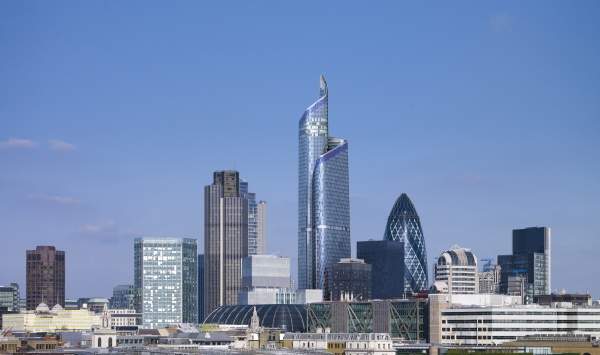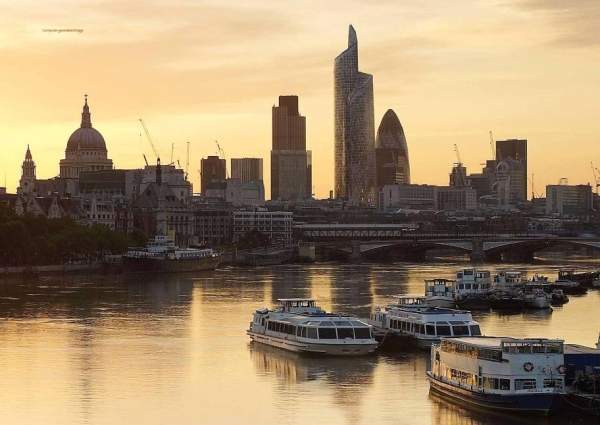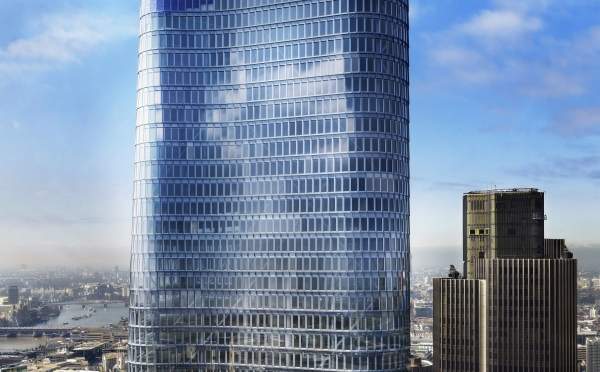The Pinnacle, formerly known as Bishopsgate Tower or Helter-Skelter, is a skyscraper under construction at the centre of London’s financial district. The tower, about 288m high, will be the tallest in the City of London and the second tallest in the European Union. The Shard London Bridge tower (310m) is the tallest in the EU.
The 63-storey Pinnacle Tower is an addition to the emerging high-rise buildings cluster comprising the Gherkin, Heron Tower, Tower 42 and 122 Leadenhall Street.
Plans to construct a skyscraper in Bishopsgate were initiated in 2002. A 216m tall tower design by Helmut Jahn was scrapped due to the concerns over the views of St. Paul’s Cathedral. Kohn Pederson Fox and the former developers Union Investment Real Estate (previously DIFA) submitted a new planning application in June 2005.
In April 2006, the City Corporation approved the tower’s construction with 19m reduced height, due to concerns from the Civil Aviation Authority.
In February 2007 Bishopsgate Tower was, however, sold to The Pinnacle No. 1 company owned by Arab Investments. Its name was subsequently changed to The Pinnacle Tower.
The skyscraper will have 90,000m2 of office space, a public viewing gallery and restaurants on the top floors. The project will substantially improve the public space at the site. Total cost of project development and tower construction is estimated to be about £1.5bn.
The Pinnacle design and architecture
The Pinnacle has a corkscrew shape, topped by a glazed spire of about 42m height. The sleek and spiralling structural design is in response to the proposed neighbouring high-rise developments and viewpoints across London.
The footprint of the Pinnacle consists of gentle curves, straight lines and tight corners. The building will taper with height and form a spire at the top. The ground level of the façade will flare into an extended and curved canopy to reduce the impact of wind. The base will act as passage for the public through the entrance hall.
Entrance at the base of the tower will feature a large canopy with triple-height tower entrance lobby and double-height retail spaces.
The canopy is designed to create a public zone and in tune with the immediate context. It will open a ground-level pedestrian access to connect major public spaces including St. Mary Axe and Bishopsgate.
Structure of the major London tower
The tower structure is tapered for aerodynamic effect. It was designed using computational parametric models. Perimeter of the main tower structure will be supported by 20 H-section fabricated plate columns. The columns will be interconnected by a set of braces for stability. This structure will give efficiency and stiffness to carry stability forces.
The columns in all floor levels will be spanned with 625mm deep fabricated plate girders. A jump form reinforced concrete core will be built to speed up the steel frame erection. The base will sit over 60 main grouted bore poles of 2.4m diameter laid at a depth of 60m below the ground level.
Façade of The Pinnacle, formerly the Bishopsgate Tower
The façade will consist of two different layers of glass with cavity in between them for free flow of air. The sealed inner layer will comprise of thermally broken, double glazed, weather proof glass.
The uninsulated, outer blue glass layer will have a snakeskin design with identical size rectangular glass panels. The flat panels will be installed at an angle and overlap each other to create partial open spaces, which protect the building against harsh winds. The exterior will eliminate the need for curved glass. It will also give a flowing look to the entire structure. The inner layer has operable windows allowing office ventilation.
Construction of the second tallest building in the European Union
The 140m x 70m site was preoccupied by three Bishopsgate office buildings built in 1980s. The old buildings were demolished between mid-2007 and June 2008. Site preparation works for the new skyscraper were started in September 2008 and piling was completed by October 2009.
The tower was scheduled to be completed by 2011. The project, however, was delayed due to financial constraints. Construction recommenced in June 2011 with the funding secured from lenders including SEDCO, HSBC and HSH Nordbank. It is now planned for completion in 2014.
Sustainability of Arab Investments’ London skyscraper
The skyscraper will incorporate several sustainable features such as low-energy cooling systems, heat recovery and reuse and an energy efficient plant. About 200kW of electricity will be produced through 90,000 photovoltaic panels planned to be installed on the rooftop and the façade at the spiralling top.
The project is targeting to meet the Excellent rating requirements of Building Research Establishment Environmental Assessment Method (BREEAM).
Contractors involved in The Pinnacle project
Brookfield Multiplex was contracted in January 2009 to build The Pinnacle. DP9 was the planning consultant.
Arup is the structural and geotechnical, acoustics, transport, wind and fire consultant engineer. Gartner, a Permasteelisa subsidiary, is the façade consultant.
Tekla Structures Building Information Modelling (BIM) software was used to determine the geometries of the overall structural design of the building.
Davis Langdon is the quantity surveyor and project manager. Hilson Moran Partnership (HMP) is the MEP engineer. Steelworks will be undertaken by a joint venture of Hollandia and Victor Buyck.
Keltbray was the contractor for demolition of the old buildings. Mace is the construction design and management (CDM) coordinator.











